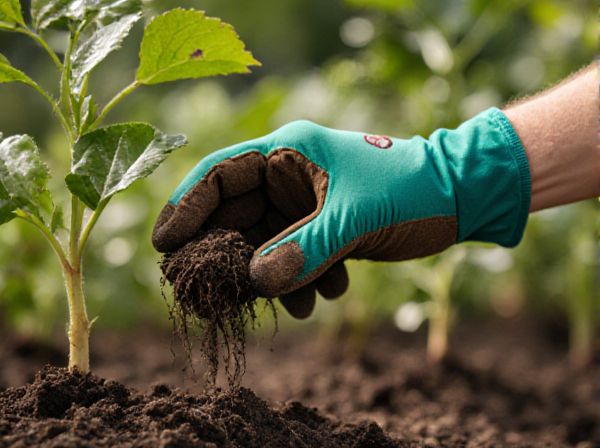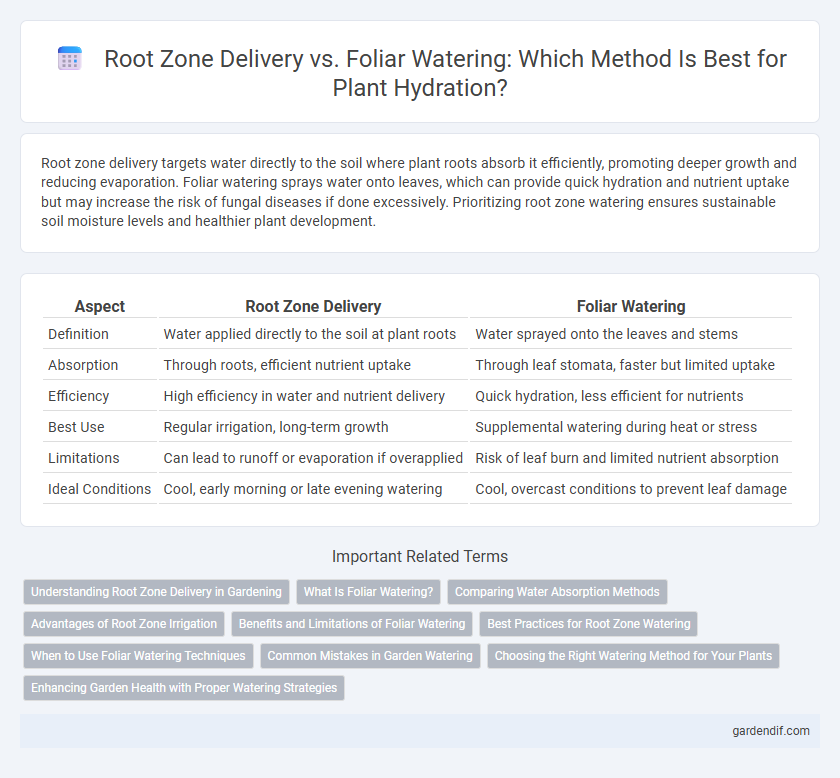
Root zone delivery vs Foliar watering Illustration
Root zone delivery targets water directly to the soil where plant roots absorb it efficiently, promoting deeper growth and reducing evaporation. Foliar watering sprays water onto leaves, which can provide quick hydration and nutrient uptake but may increase the risk of fungal diseases if done excessively. Prioritizing root zone watering ensures sustainable soil moisture levels and healthier plant development.
Table of Comparison
| Aspect | Root Zone Delivery | Foliar Watering |
|---|---|---|
| Definition | Water applied directly to the soil at plant roots | Water sprayed onto the leaves and stems |
| Absorption | Through roots, efficient nutrient uptake | Through leaf stomata, faster but limited uptake |
| Efficiency | High efficiency in water and nutrient delivery | Quick hydration, less efficient for nutrients |
| Best Use | Regular irrigation, long-term growth | Supplemental watering during heat or stress |
| Limitations | Can lead to runoff or evaporation if overapplied | Risk of leaf burn and limited nutrient absorption |
| Ideal Conditions | Cool, early morning or late evening watering | Cool, overcast conditions to prevent leaf damage |
Understanding Root Zone Delivery in Gardening
Root zone delivery targets water directly to the soil surrounding plant roots, maximizing absorption and minimizing evaporation losses compared to foliar watering. This method supports deep root growth and improves nutrient uptake efficiency by maintaining consistent moisture levels where plants access water most effectively. Understanding root zone delivery enhances irrigation practices, promoting healthier plants and conserving water resources in gardening.
What Is Foliar Watering?
Foliar watering involves spraying water directly onto the leaves of plants, allowing nutrients and moisture to be absorbed through the stomata and epidermis. This method supplements root zone delivery by providing immediate hydration and nutrient uptake, especially in conditions where soil absorption is limited. Foliar watering enhances plant health by improving photosynthesis efficiency and reducing water wastage compared to traditional soil irrigation.
Comparing Water Absorption Methods
Root zone delivery targets water directly to the soil where plant roots absorb moisture efficiently, promoting deeper root growth and improving nutrient uptake. Foliar watering involves spraying water onto leaves, leading to some absorption through stomata but generally providing limited hydration compared to root zone delivery. Studies show root zone irrigation results in higher overall water use efficiency and better plant health compared to foliar methods, which are more supplementary during dry conditions.
Advantages of Root Zone Irrigation
Root zone irrigation delivers water directly to the soil area around plant roots, enhancing absorption efficiency and reducing water waste compared to foliar watering. It minimizes leaf wetness, lowering the risk of fungal diseases and improving plant health. This method supports deeper root growth and maintains optimal soil moisture, promoting stronger and more resilient crops.
Benefits and Limitations of Foliar Watering
Foliar watering enhances nutrient absorption efficiency by delivering water and nutrients directly to plant leaves, improving growth during dry periods or when root uptake is impaired. This method reduces water waste and mitigates soil-borne diseases but has limitations such as susceptibility to rapid water evaporation and potential leaf burn under intense sunlight. Optimal foliar applications require precise timing and environmental control to maximize benefits while minimizing stress on plant foliage.
Best Practices for Root Zone Watering
Root zone watering targets the soil around plant roots, ensuring deep moisture penetration critical for healthy growth and nutrient uptake, unlike foliar watering which only moistens leaves temporarily. Best practices include applying water slowly with drip irrigation or soaker hoses to minimize runoff and promote deep root absorption. Maintaining consistent soil moisture and avoiding water stress enhances root development and plant resilience.
When to Use Foliar Watering Techniques
Foliar watering is most effective during early morning or late afternoon when stomata are open, allowing for optimal nutrient absorption. This technique suits plants with slow root development or those experiencing drought stress, providing rapid hydration and nutrient uptake. Avoid foliar watering during midday heat to prevent leaf scorch and ensure maximum efficiency.
Common Mistakes in Garden Watering
Root zone delivery often leads to deeper soil moisture, promoting stronger plant roots, while foliar watering primarily targets leaves but can increase the risk of fungal diseases if overused. Common mistakes include watering foliage during peak sunlight, causing leaf burn, and applying water unevenly, which results in dry patches or water runoff. Ensuring water reaches the root zone efficiently and avoiding excessive foliar wetness enhances overall garden health and water use efficiency.
Choosing the Right Watering Method for Your Plants
Root zone delivery ensures water reaches the plant's root system directly, promoting deeper growth and nutrient absorption. Foliar watering, by contrast, targets leaves and can quickly alleviate surface dehydration but is less effective for sustained hydration. Selecting the right watering method depends on the plant species, soil type, and environmental conditions to optimize water efficiency and plant health.
Enhancing Garden Health with Proper Watering Strategies
Root zone delivery targets water directly to the plant's root system, promoting deeper root growth and efficient nutrient absorption, which enhances overall garden health. Foliar watering involves spraying water onto leaves, providing immediate hydration and potential nutrient uptake through leaves but carries risks of fungal diseases if done excessively. Balancing these methods optimizes soil moisture levels and plant hydration, ultimately supporting vigorous growth and resilience in garden plants.
Root zone delivery vs Foliar watering Infographic

 gardendif.com
gardendif.com